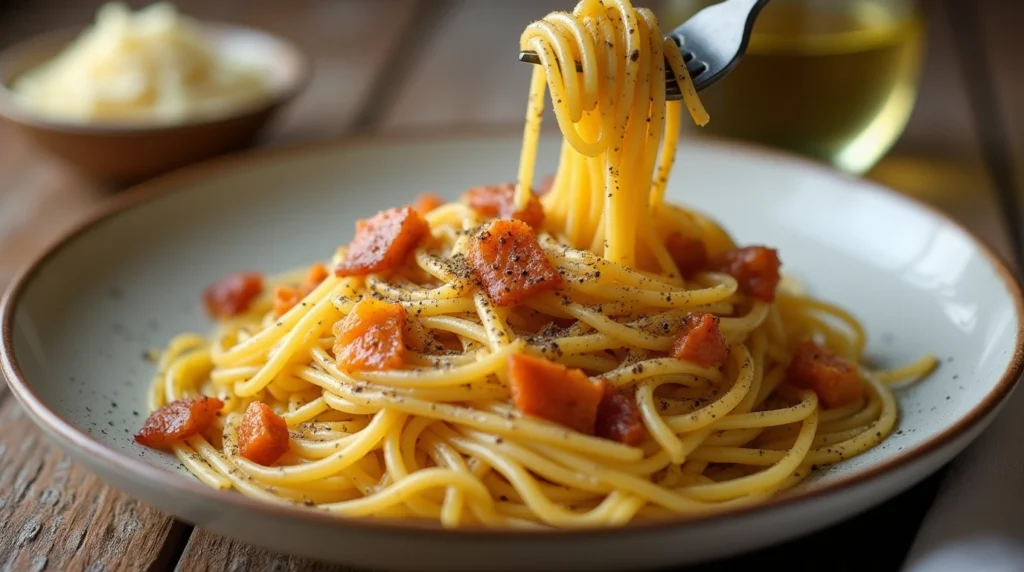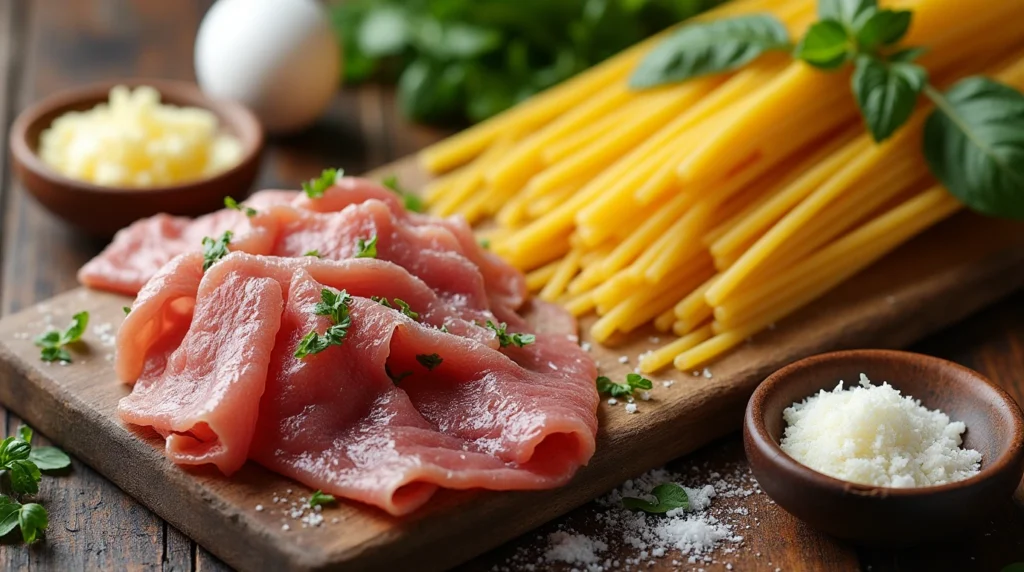guanciale
A staple of Roman cuisine, Spaghetti alla Carbonara captures the soul of traditional Italian cooking, brought to life by the bold, savory essence of guanciale—cured pork jowl that adds depth and character to every bite. Unlike versions that use pancetta or bacon, authentic carbonara relies on guanciale’s distinctive taste profile which offers a perfect balance of meaty richness and delicate fat that melts beautifully when cooked. The guanciale provides a depth of flavor that’s slightly sweeter and more complex than other cured pork products, with subtle notes of herbs from the curing process.

Spaghetti alla Carbonara & Guanciale: Ultimate Roman Bliss
This classic preparation combines crispy guanciale with a silky sauce created from eggs and Pecorino Romano cheese. The heat from the freshly cooked pasta gently cooks the egg mixture, resulting in a creamy, luscious coating without becoming scrambled. The addition of abundant freshly ground black pepper provides a peppery bite that cuts through the richness of the dish. When prepared correctly, this carbonara achieves a perfect harmony of textures and flavors – the al dente bite of the pasta, the crispy-chewy guanciale pieces, and the smooth, velvety sauce that clings to every strand of spaghetti.
This recipe stays true to Roman tradition with no cream, no garlic, and no onion – just the pure, simple perfection of quality ingredients coming together in a dish that’s simultaneously humble and luxurious. The guanciale is truly the star ingredient, providing the foundation of flavor that makes authentic carbonara so unforgettable.
📌 Number of Servings: 4
⏳ Preparation Time: 15 minutes
🔥 Cooking Time: 15 minutes
🥢 Ingredients :

✅ 1 pound (450g) spaghetti
✅ 8 ounces (225g) guanciale, cut into ¼-inch thick strips
✅ 4 large eggs (at room temperature)
✅ 1 large egg yolk (at room temperature)
✅ 1 cup (100g) freshly grated Pecorino Romano cheese
✅ 1 teaspoon freshly ground black pepper, plus more to serve
✅ Salt (for pasta water)
👨🍳 Instructions :
- Bring a large pot of water to a boil. Add salt generously (about 1 tablespoon per liter of water).
- While the water is heating, cut the guanciale into ¼-inch thick strips or small cubes.
- In a large bowl, whisk together the eggs, egg yolk, grated Pecorino Romano, and black pepper until well combined. Set aside.
- Add spaghetti to the boiling water and cook until al dente according to package instructions (usually 9-11 minutes).
- While the pasta cooks, add the guanciale to a large, cold skillet. Place over medium heat and cook slowly until the fat renders and the guanciale becomes crispy but not burned, about 8-10 minutes.
- When the guanciale is crispy, remove the skillet from heat. You can leave all the rendered fat in the pan or remove some if you prefer a lighter dish.
- When the pasta is al dente, reserve 1 cup of the pasta cooking water, then drain the pasta.
- Immediately add the hot pasta to the skillet with the guanciale and toss to coat. Allow it to cool for about 30 seconds.
- Working quickly, pour the egg and cheese mixture over the pasta, tossing constantly with tongs to create a creamy sauce. The residual heat will cook the eggs gently without scrambling them.
- If the sauce is too thick, add a splash of the reserved pasta water to achieve a silky consistency.
- Serve immediately, with additional grated Pecorino Romano and freshly ground black pepper on top.
💡 TIPS :
- Always use room temperature eggs to prevent them from seizing when they hit the hot pasta.
- Don’t add raw eggs directly to very hot pasta – let it cool for 30 seconds before adding the egg mixture to prevent scrambling.
- True Roman carbonara never includes cream, garlic, or onions.
- Authentic guanciale has a distinctive flavor that’s difficult to substitute, but if you absolutely cannot find it, pancetta is the next best option.
- Adding pasta water gradually helps achieve the perfect sauce consistency.
- Toss continuously when adding the egg mixture to ensure even coating and proper cooking.
- Pecorino Romano is traditionally used, not Parmigiano Reggiano, though the latter can be substituted in a pinch.
- Serve immediately after preparing for the best texture and flavor experience.
📊 Nutrition Information (per serving)
- Calories: 750
- Total Fat: 35g
- Saturated Fat: 15g
- Cholesterol: 275mg
- Sodium: 890mg
- Total Carbohydrate: 75g
- Dietary Fiber: 3g
- Sugars: 3g
- Protein: 33g
❓ FAQ :
- What exactly is guanciale and how is it different from pancetta or bacon? Guanciale is cured pork jowl (cheek) that has a higher fat content and unique flavor compared to pancetta (cured pork belly) or bacon (smoked pork belly). It has a more delicate, sweeter taste with herbal notes from its curing process.
- Where can I find guanciale if my local grocery store doesn’t carry it? Italian specialty markets, gourmet food shops, and butchers specializing in charcuterie typically carry guanciale. You can also order it online from specialty food retailers.
- My sauce turned into scrambled eggs. What went wrong? This happens when the eggs are added to pasta that’s too hot. Make sure to remove the pan from heat and let the pasta cool slightly before adding the egg mixture, and keep tossing constantly.
- Can I make carbonara ahead of time? Carbonara is best enjoyed immediately after preparing. The sauce can separate or become dry when reheated, and the texture suffers significantly.
- Is carbonara safe to eat since the eggs aren’t fully cooked? The hot pasta does partially cook the eggs, bringing them to a safe temperature. If you’re concerned, use pasteurized eggs, especially for those with compromised immune systems, pregnant women, or the elderly.
- Can I add cream to make the sauce creamier? Traditional Roman carbonara never includes cream. The creaminess comes from the emulsion of eggs, cheese, and starchy pasta water. Adding cream changes the dish fundamentally.
- Why is my carbonara sauce too dry? Always reserve pasta water before draining. If your sauce is too dry, add a splash of the starchy water and toss to create the silky consistency characteristic of proper carbonara.
- Can I use a different pasta shape? While spaghetti is traditional, rigatoni, bucatini, and fettuccine are acceptable alternatives that hold the sauce well.
- How do I store leftover guanciale? Wrap unused guanciale tightly in butcher paper or plastic wrap and store in the refrigerator for up to 3 weeks, or freeze for up to 3 months.
- Is carbonara supposed to be spicy? Authentic carbonara isn’t spicy but has a pronounced black pepper presence. The dish’s name “carbonara” may derive from “carbone” (coal), with the abundant black pepper resembling coal flecks.
Related

